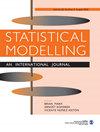Dynamic modelling of corporate credit ratings and defaults
IF 1.2
4区 数学
Q2 STATISTICS & PROBABILITY
引用次数: 0
Abstract
In this article, we propose a longitudinal multivariate model for binary and ordinal outcomes to describe the dynamic relationship among firm defaults and credit ratings from various raters. The latent probability of default is modelled as a dynamic process which contains additive firm-specific effects, a latent systematic factor representing the business cycle and idiosyncratic observed and unobserved factors. The joint set-up also facilitates the estimation of a bias for each rater which captures changes in the rating standards of the rating agencies. Bayesian estimation techniques are employed to estimate the parameters of interest. Several models are compared based on their out-of-sample prediction ability and we find that the proposed model outperforms simpler specifications. The joint framework is illustrated on a sample of publicly traded US corporates which are rated by at least one of the credit rating agencies S&P, Moody's and Fitch during the period 1995–2014.企业信用评级和违约的动态建模
在本文中,我们提出了一个二元和有序结果的纵向多变量模型,以描述不同评级机构的企业违约和信用评级之间的动态关系。潜在违约概率被建模为一个动态过程,其中包含附加的企业特定效应、代表商业周期的潜在系统因素以及特殊的观察到和未观察到的因素。联合设置也有助于估计每个评级机构的偏差,从而反映评级机构评级标准的变化。采用贝叶斯估计技术来估计感兴趣的参数。基于样本外预测能力对几种模型进行了比较,我们发现所提出的模型优于更简单的规范。该联合框架以1995-2014年期间至少由一家信用评级机构标准普尔、穆迪和惠誉评级的美国上市公司为样本进行了说明。
本文章由计算机程序翻译,如有差异,请以英文原文为准。
求助全文
约1分钟内获得全文
求助全文
来源期刊

Statistical Modelling
数学-统计学与概率论
CiteScore
2.20
自引率
0.00%
发文量
16
审稿时长
>12 weeks
期刊介绍:
The primary aim of the journal is to publish original and high-quality articles that recognize statistical modelling as the general framework for the application of statistical ideas. Submissions must reflect important developments, extensions, and applications in statistical modelling. The journal also encourages submissions that describe scientifically interesting, complex or novel statistical modelling aspects from a wide diversity of disciplines, and submissions that embrace the diversity of applied statistical modelling.
 求助内容:
求助内容: 应助结果提醒方式:
应助结果提醒方式:


